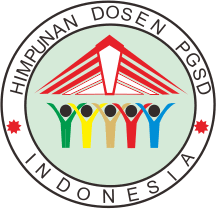Pengembangan Media Pembelajaran Interaktif Berbasis Articulate Storyline pada Materi Keliling dan Luas Bangun Datar
Abstract
Mathematics is very useful in everyday life. Based on this, mathematics is important to learn. Nevertheless, the facts found in the field of mathematics learning outcomes are still very low. Media learning is one of the things that can affect the quality of math learning. Based on the results of interviews and observations at SDN Dukuhan Kerten, it was found that there were problems with the limitations of mathematics learning media on the circumference and area of flat shapes. Therefore, this study aims to develop an interactive learning medium based on articulated storylines on the material circumference flat shapes and areas. This type of research is development research using a 4D research model (Define, design, development, and desiminate). The implementation of this research was carried out only at the development stage. Data collection techniques in this study used interviews, observations, documentation studies, and questionnaires. The results of this study are valid learning media based on the percentage of material expert assessment of 89.3% and the percentage of media expert assessment of 93.1%. The results of this study are also in the form of practical learning media based on teacher assessments with a percentage of 96.4% and student assessments with a percentage of 91.54%.
Keywords
Full Text:
PDFReferences
[1] A. Jalil, “Matematika dalam Perspektif Sosial Budaya,” in Prosding SNPMAT 1 Tahun 2018, 2018, vol. 1, hal. 27–35.
[2] K. Kamarullah, “Pendidikan Matematika di Sekolah Kita,” Al Khawarizmi J. Pendidik. dan Pembelajaran Mat., vol. 1, no. 1, hal. 21–32, 2017, doi: 10.22373/jppm.v1i1.1729.
[3] L. Hewi dan M. Shaleh, “Refleksi Hasil PISA (The Programme For International Student Assesment): Upaya Perbaikan Bertumpu Pada Pendidikan Anak Usia Dini),” J. Golden Age, Univ. Hamzanwadi, vol. 04, no. 1, hal. 30–41, 2020, doi: 10.29408/jga.v4i01.2018.
[4] E. Aldiyah, “Perubahan Gaya Belajar di Masa Pandemi Covid-19,” Cendekia J. Ilmu Pengetah., vol. 1, no. 1, hal. 8–16, 2021.
[5] L. Hartati, “Pengaruh Gaya Belajar dan Sikap Siswa pada Pelajaran Matematika terhadap Hasil Belajar Matematika,” Form. J. Ilm. Pendidik. MIPA, vol. 3, no. 3, hal. 224–235, 2015, doi: 10.30998/formatif.v3i3.128.
[6] I. T. M. Pratiwi dan R. I. Meilani, “Peran Media Pembelajaran Dalam Meningkatkan Prestasi Belajar Siswa,” J. Pendidik. Manaj. Perkantoran, vol. 3, no. 2, hal. 33, 2018, doi: 10.17509/jpm.v3i2.11762.
[7] R. Sundayana, MEDIA DAN ALAT PERAGA DALAM PEMBELAJARAN MATEMATIKA, 4 ed. Bandung: Penerbit Alfabeta, 2018.
[8] Sugiyono, “Metode Penelitian dan Pengembangan Pendekatan Kualitatif, Kuantitatif, dan R&D,” Metod. Penelit. dan Pengemb. Pendekatan Kualitatif, Kuantitatif, dan R&D, hal. 130, 2015.
[9] S. Thiagarajan, D. S. Semmel, dan M. I. Semmel, Instructional Development for Training Teachers of Exceptional Children A Source Book. Bloomington: Indiana Univ, 1974.
[10] H. A. Puspawardani dan Y. Yermiandhoko, “Pengembangan Visual Interactive Learning Media Berbasis Virtual Roaming Game dengan Pendekatan RME pada Materi Bangun Datar Kelas 4 SDN 01 Demuk,” J. Penelit. Pendidik. Guru Sekol. Dasar, vol. 9, no. 10, hal. 3503–3514, 2022.
[11] M. C. Paseleng dan R. Arfiyani, “Pengimplementasian Media Pembelajaran Berbasis Multimedia Interaktif pada Mata Pelajaran Matematika di Sekolah Dasar,” J. Pendidik. dan Kebud., vol. 5, no. 2, hal. 131–149, 2015, doi: https://doi.org/10.24246/j.scholaria.2015.v5.i2.p131-149.
[12] M. Istiqlal, “Pengembangan Multimedia Interaktif Dalam Pembelajaran Matematika,” J. Ilm. Pendidik. Mat., vol. 2, no. 1, 2017, doi: 10.26877/jipmat.v2i1.1480.
[13] M. T. Apriyanto dan R. A. Hilmi, “Media pembelajaran matematika (mobile learning) berbasis android,” Semin. Nas. Penelit. Pendidik. Mat., hal. 115–124, 2019.
[14] H. A. Sanaky, Media Pembelajaran Interaktif-Inovatif, 1 ed. Yogyakarta: Kaukaba Dipantara, 2015.
[15] N. Suryani, A. Setiawan, dan A. Putria, Media Pembelajaran Inovatif dan Pengembangannya, 1 ed. Bandung: PT Remaja Rosadakarya, 2018.
[16] Indirawati Leztiyani, “Articulate Storyline; Interactive Teaching Tools,” J. Pendidik. Indones., vol. 2, no. 1, hal. 24–35, 2021.
[17] A. Arsyad, Media Pembelajaran, 2 ed. Depok: PT RajaGrafindo Persada, 2019.
[18] N. Nieveen, J. van den Akker, M. R. Branch, dan T. Plomp, Design Approaches and Tools in Education and Training, vol. 29, no. 7. Dordrecth: Kluwer Akademic, 1999.
[19] N. Nuryadi dan N. Khuzaini, “Keefektifan Media Matematika Virtual Berbasis Teams Game Tournament Ditinjau Dari Cognitive Load Theory,” J. Mercumatika J. Penelit. Mat. dan Pendidik. Mat., vol. 2, no. 2, hal. 57–68, 2017, doi: 10.26486/jm.v2i2.370.
Refbacks
- There are currently no refbacks.



